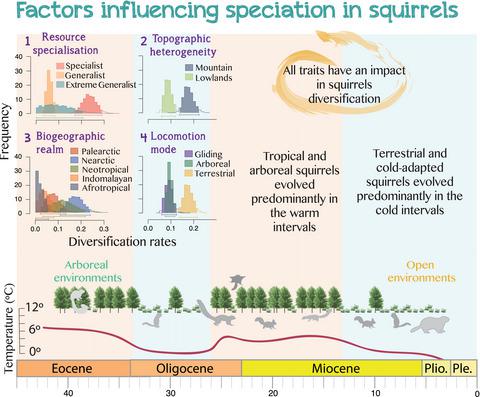当前位置:
X-MOL 学术
›
Mammal Rev.
›
论文详情
Our official English website, www.x-mol.net, welcomes your
feedback! (Note: you will need to create a separate account there.)
A multi‐layered approach to the diversification of squirrels
Mammal Review ( IF 4.3 ) Pub Date : 2020-10-07 , DOI: 10.1111/mam.12215 Iris Menéndez 1, 2 , Ana Rosa Gómez Cano 3 , Juan L. Cantalapiedra 4 , Pablo Peláez‐Campomanes 5 , María Ángeles Álvarez‐Sierra 1, 2 , Manuel Hernández Fernández 1, 2
中文翻译:

松鼠多样化的多层次方法
更新日期:2020-10-07
Mammal Review ( IF 4.3 ) Pub Date : 2020-10-07 , DOI: 10.1111/mam.12215 Iris Menéndez 1, 2 , Ana Rosa Gómez Cano 3 , Juan L. Cantalapiedra 4 , Pablo Peláez‐Campomanes 5 , María Ángeles Álvarez‐Sierra 1, 2 , Manuel Hernández Fernández 1, 2
Affiliation

|
- The shape of the tree of life is the result of shifting diversification rates, and identifying the factors driving these shifts is one of the main aims in evolutionary biology. Various biotic and abiotic factors have been proposed to have an impact on mammal diversification, such as climatic and tectonic changes, the acquisition of new traits, and expansion into new ecosystems or landmasses.
- We used phylogenetic comparative methods to quantify the influence of potential drivers on diversification patterns in extant squirrels (Sciuridae, Rodentia). We conducted a multilayer approach, comparing diversification rates among squirrel lineages depending on their degree of biome specialisation, biogeographic realm occupancy, locomotion adaptations, and presence in mountainous regions.
- We generated the most complete phylogeny of squirrels to date, encompassing almost 80% of the extant species, and applied multiple and binary state‐dependent diversification models. All the traits examined showed an influence on diversification rates.
- The biome specialist lineages showed the highest speciation rates, suggesting a major role of bioclimatic specialisation on macroevolutionary patterns. A single major event, the Miocene–Pleistocene radiation of terrestrial‐adapted lineages in North America, left a signal that was recovered in two of our analyses. Both the Nearctic lineages and the terrestrial‐adapted lineages showed high speciation rates, highlighting the fact that that major evolutionary episodes may produce confounding effects in state‐dependent diversification models.
- Ancestral reconstructions showed that cold and warm intervals in Earth’s history had different effects on squirrels’ diversification, depending on their climatic affinities. Tropical and arboreal squirrels evolved predominantly in the warm intervals, while terrestrial and cold‐adapted squirrels radiated in the cold intervals.
- Our findings suggest that, while global climatic shifts are key for the speciation processes in mammalian lineages, lineage‐specific ecological adaptations are critical modulators of the responses of lineages to such environmental shifts, in an interplay that ultimately affects their diversification patterns.
中文翻译:

松鼠多样化的多层次方法
- 生命之树的形状是多样化速度变化的结果,而识别驱动这些变化的因素是进化生物学的主要目标之一。已经提出了各种生物和非生物因素对哺乳动物的多样化产生影响,例如气候和构造变化,新特征的获得以及向新生态系统或陆地的扩展。
- 我们使用系统发育比较方法来量化现有松鼠(Sciuridae,Rodentia)中潜在驱动因素对多样化模式的影响。我们进行了多层研究,根据松鼠谱系的生物群落专业化程度,生物地理领域的占有率,运动适应性以及在山区的存在情况,比较了松鼠谱系之间的多样化率。
- 我们生成了迄今为止最完整的松鼠系统发育学,涵盖了近80%的现存物种,并应用了多种和二元状态依存的多样化模型。所有检查过的特征都显示出对多元化率的影响。
- 生物群落专家谱系显示出最高的物种形成率,表明生物气候专业化在宏观进化模式中起着重要作用。一个重大事件,即北美地区适应世袭的中新世—更新世辐射,留下了一个信号,该信号在我们的两次分析中得到了恢复。Nearctic世系和陆地适应世系都显示出高的物种形成率,这突显了一个事实,即主要的进化事件可能会在依赖国家的多元化模型中产生混杂效应。
- 祖先的重建表明,地球历史上的冷暖间隔对松鼠的多样化有不同的影响,这取决于它们的气候亲和力。热带松鼠和树栖松鼠主要在温暖的时间间隔内进化,而陆地和寒冷适应的松鼠则在寒冷的时间间隔内辐射。
- 我们的发现表明,尽管全球气候变化是哺乳动物谱系形成过程的关键,但特定于谱系的生态适应是谱系对这种环境变化的反应的关键调节剂,相互作用最终影响了它们的多样化模式。











































 京公网安备 11010802027423号
京公网安备 11010802027423号